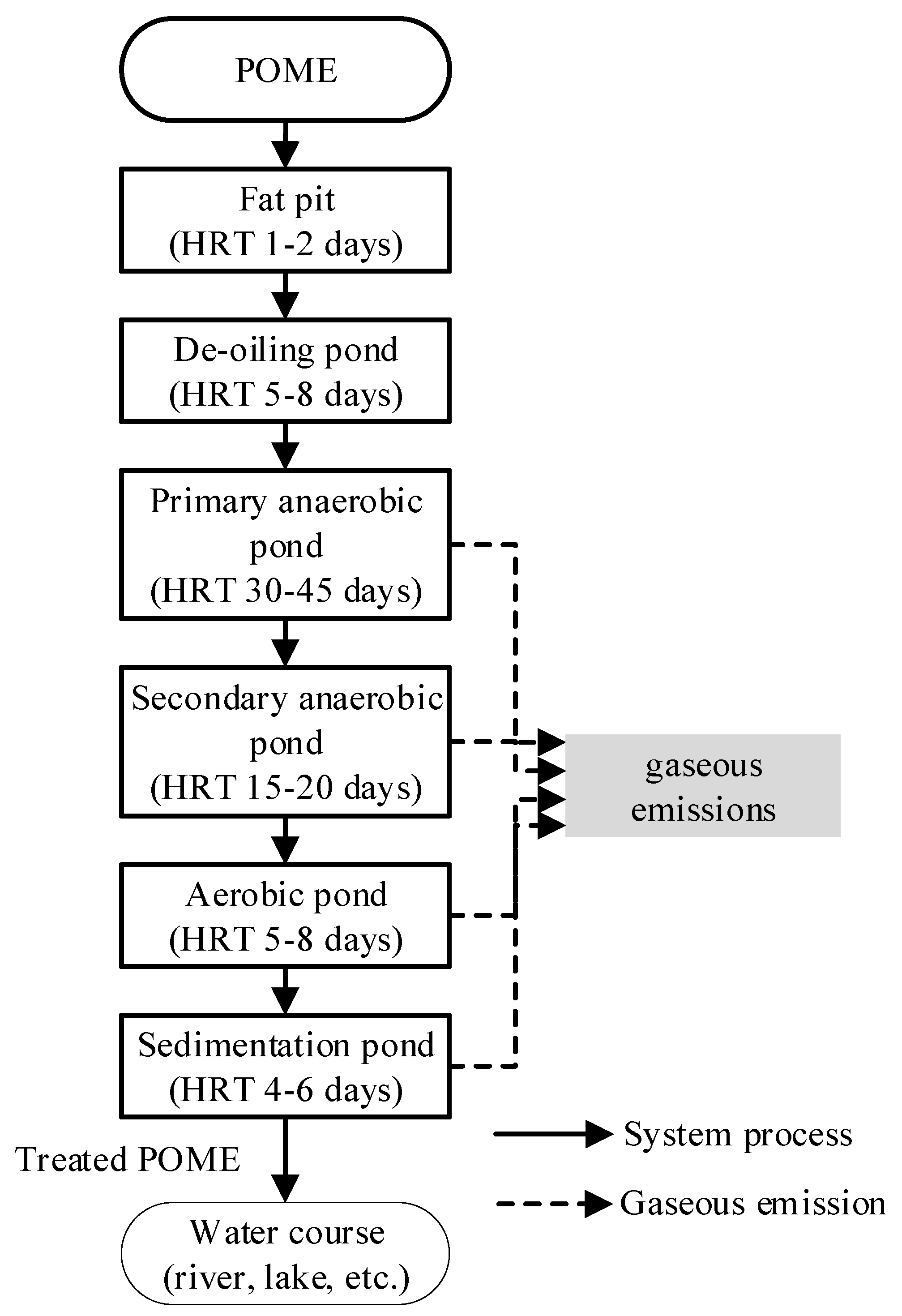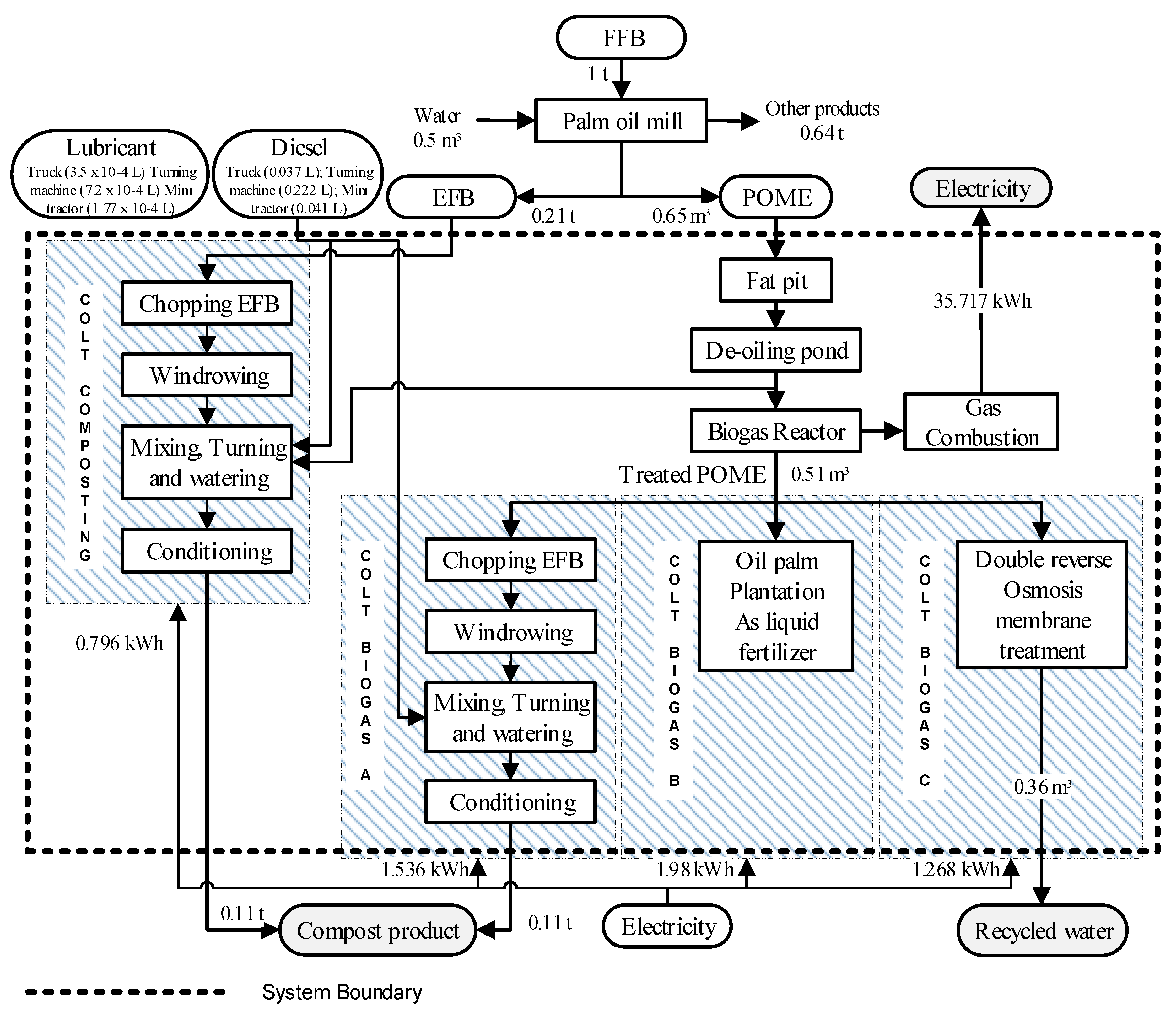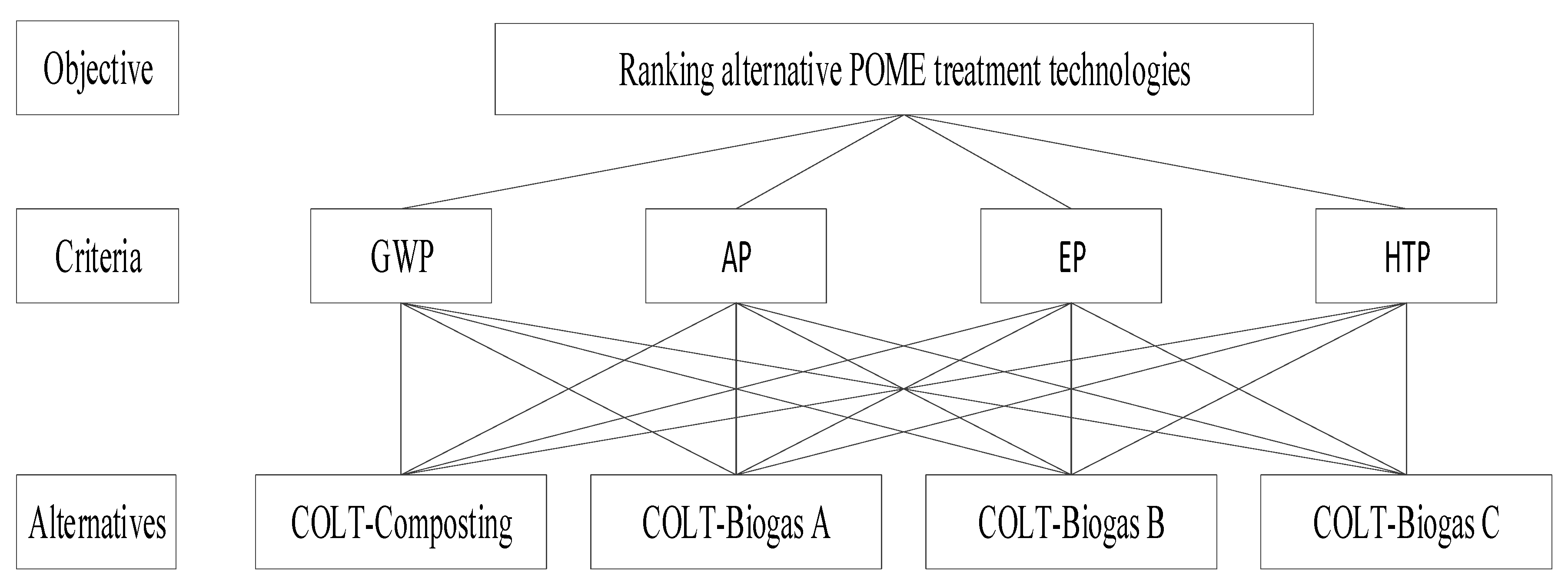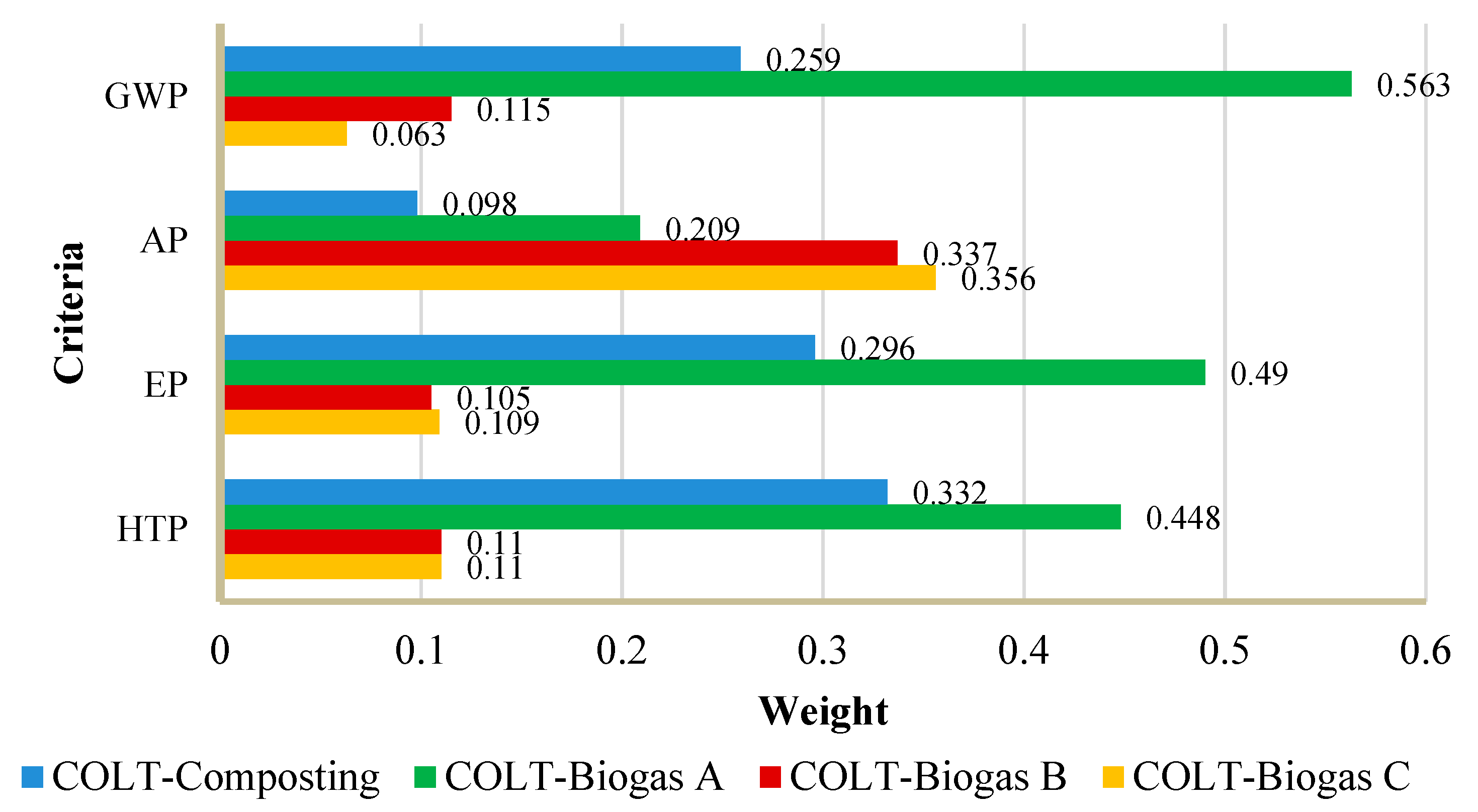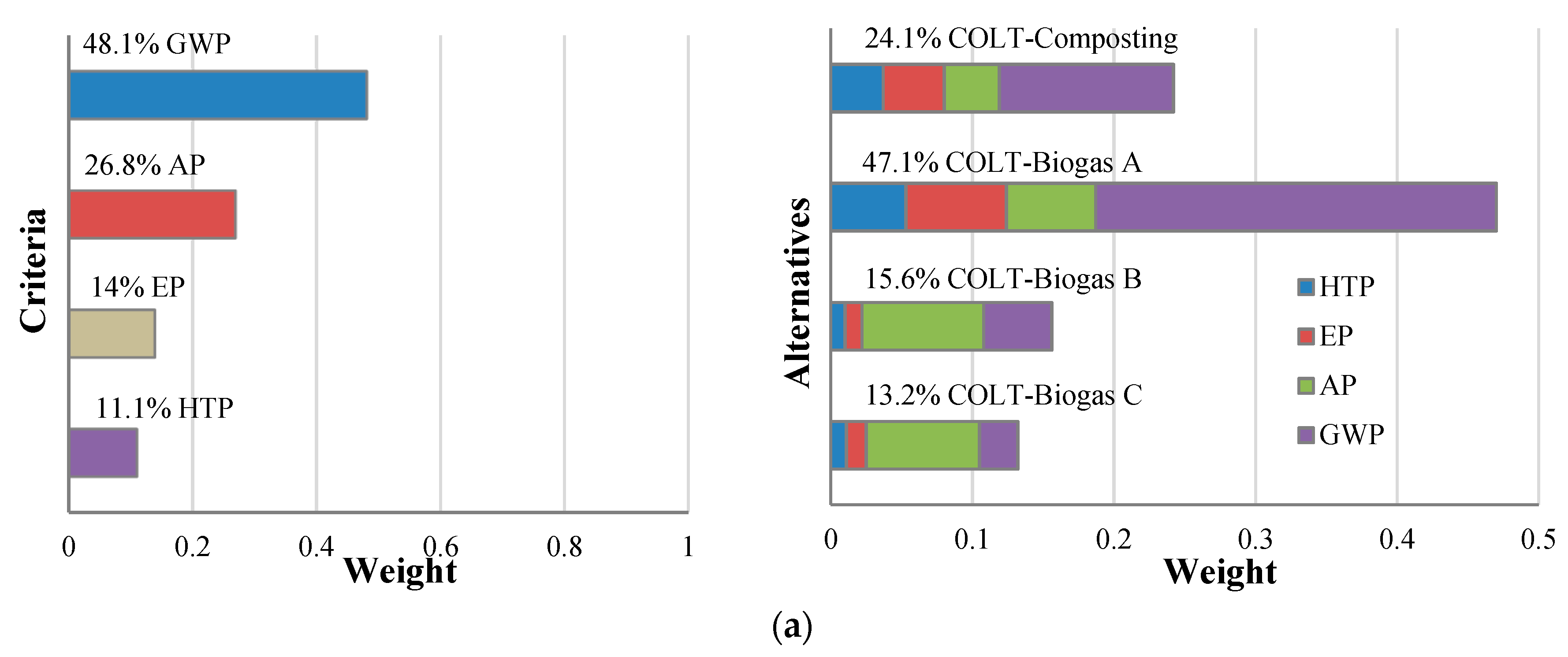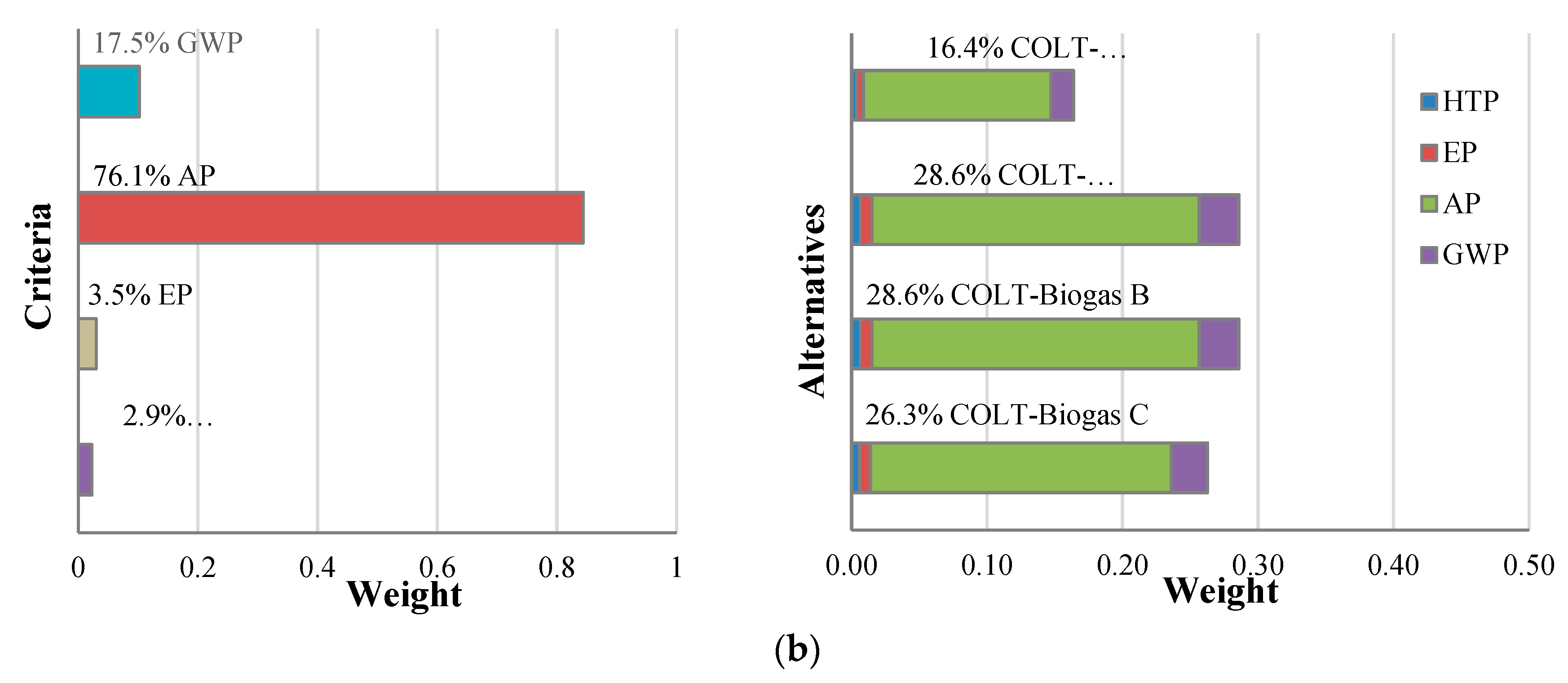2.1. POME Treatment
POME treatment technology is still dominated by open lagoon technology, which is known as the simplest and cheapest method (
Figure 1). However, this technology emits abundant GHGs, especially from anaerobic and aerobic ponds [
16]. In this study, two alternatives to POME treatment combined with open lagoon technology were analyzed: one with composting, and the second with biogas technology. As composting and biogas technology require fat pits and de-oiling ponds as the final collection point of crude palm oil, a combination of open lagoon technology (COLT–Composting), and COLT–Biogas was evaluated. COLT-Composting is one of the proven technologies that produce compost as an organic fertilizer [
17]. The composting process is co-composting between POME and EFB as the material involved. COLT–Biogas is a technology that can produce biogas by fermentation in an anaerobic digester. Finally, the biogas could be converted to electricity by using the gas engine after purification of CO
2, desulfurization, and dewatering. In this study, treated POME from COLT–Biogas had chemical oxygen demand (COD) content that exceeded the discharge limit of the waterway entering the river. The POME was treated using composting technology (COLT–Biogas A), land application technology (COLT–Biogas B), and membrane technology (COLT–Biogas C).
COLT–Biogas A is a combination of the COLT–Biogas technology with composting technology (
Figure 3). The composting process in this alternative is similar to that of the COLT–Composting technology. However, the source of POME for watering the EFB during the fermentation process uses treated POME. Meanwhile, COLT–Composting uses POME from the de-oiling pond. COLT–Biogas B requires the POME to be applied to the land as a final treatment for treated POME from the biogas reactor. The land application has liquid fertilizer that flows to the plantation. COLT–Biogas C is a combination of biogas technology and membrane technology. A double reverse osmosis membrane was used for this combination of technologies. The information about whole POME alternative treatments is referred to in our previous study [
18].
COLT–Biogas B is a combination of technologies that use biogas technology as the first treatment technology, followed by land application technology. As COD of treated POME of biogas still exceeds the standard environmental acceptance criteria when released to the surrounding area (such as rivers and lakes), land application technology is used as the final technology to treat the treated POME from the biogas reactor/digester, resulting in fertilizer in its liquid form being applied to the palm plantations.
2.2. Life Cycle Assessment
As the initial step in the analysis of POME treatment technology, the LCA results of our previous study were used as criteria in the second step of MCDA. In our previous study, LCA was performed to compare and analyze the alternatives to POME treatment technology [
18]. The method was used to calculate the LCA result based on the LCA standard assessment by following the ISO 14040 series and SimaPro® version 8.1.1.16 (Pre Consultants, Holland) was used as the LCA analysis tool. The functional unit is replaced per ton of FFB. The gate-to-gate system boundary was used in this study (
Figure 3). This study preferred to use the environment impact assessment midpoint rather than environment impact endpoint, as the midpoint result was more familiar to the study unit [
19]. Yi (2014) reported that more than 65% of the 1000 respondents preferred the impact assessment midpoint for the LCA study. The midpoint environmental categories are global warming potential (GWP), eutrophication potential (EP), acidification potential (AP), and human toxicity potential (HTP). Inventory analysis and experimental data, including mass and energy balance, were undertaken and collected by field survey from a palm oil mill located in North Sumatra. Mass and energy balances were conducted to quantify the total elementary input and output flows, recycled water, and energy required according to the system boundaries. The GWP, EP, and AP were obtained as follows:
where
(carbon dioxide emissions from electricity)
(carbon dioxide emissions from the lubricant),
(carbon dioxide emissions from diesel fuel),
(Carbon dioxide emissions related to methane emissions from composting),
(carbon dioxide emissions related to methane emissions from the open lagoon),
(Carbon dioxide emissions related to untreated EFB) = EFB dumping (230 kg CO
2-eq per ton of FFB)
where
(PO
4 emissions related to
P compounds in POME),
(PO
4 emissions related to
P compounds in POME),
(PO
4 emissions related to
P compounds in EFB),
(PO
4 emissions related to
P compounds in EFB),
where
(SO
2 emissions related to H
2S compounds in biogas),
(SO
2 emissions related to H
2S compounds in diesel combustion),
Furthermore, HTP was calculated and collected from a previous study [
18], which included a method developed by Stichnothe and Schuchardt [
20]. The LCA results were difficult to interpret to find a specific outcome because there was little variation between the environmental impact value of each alternative technology. For example, the GWP COLT–Composting was 18.79 kg CO
2-eq, which was not much different from 14.01 kg CO
2-eq the GWP of COLT–Biogas A (
Table 2). In addition, the category value fluctuated. Some alternatives had the highest in one category and had lower values in other categories. For example, COLT–Biogas A had the highest AP, but the lowest GWP.
2.3. Analytical Hierarchy Process
AHP is a decision-making methodology that assumes that criteria or sub-criteria are independent of each other. The differentiation between criteria is significant as it can be an indicator of the importance of alternative criteria. Priority is given according to the percentage attributed to the alternatives. In the application and analysis of AHPs, it is assumed that statistical significance is limited. AHP is a subjective comparison that, in some cases, does not require a specific number of participants’ involvement in developing the AHP model. Moreover, AHP has a good correlation with the expertise level of the participants. Furthermore, to clarify our AHP model as one of the objectives of our research, we selected experts in this field as participants.
Expert professionals have observation, knowledge, and experience regarding POME treatment in Indonesia and North Sumatra. The experts are affiliated with reputed oil palm industry companies, which have at least one plantation and palm oil mill in North Sumatra, Indonesia. Furthermore, the experts from these companies have collaborated with the Oil Palm Research Institute and the Indonesian Palm Oil Association on POME-based treatment technology. These individual experts have 15–35 years of POME treatment experience and come from established reputable institutions having 20–100 years of experience in oil palm research and production. Therefore, a series of weighted assessments by experts were selected for the AHP model.
The AHP steps for this study were as follows: Step (1) Determined the AHP model that influences the decision-making process. Based on the LCA results, the model of AHP for this study is shown in
Figure 4. The criteria used were GWP, AP, EP, and HTP. Step (2) Determined the alternative establishment for AHP modeling, as shown in
Table 2. This table was summarized based on the results of the environmental assessment and for decision-makers and respondents to prepare pairwise comparison [
21]. In addition, we determined the preferences of the alternatives. This result was described in our previous research [
18]. Open lagoon technology, as the existing technology for POME treatment, was used as a base reference for comparison with the alternative technologies (
Table 2). The quantified questionnaire responses were collected by adopting joint comparison matrices using Saaty’s nine-point scale (
Table 3) [
22].
Step (3) The questionnaire for pairwise comparisons was prepared and distributed among eight experts who had experience and knowledge about POME and/or LCA. The experts joined the questionnaire, and the proposed sampling procedure was followed. The experts were affiliated with reputable palm oil companies, industry, university, and government (
Table 4).
The collected responses were tested for consistency, and final decisions were made about the preferences of POME treatment technologies. Step (4): Collation and calculations of different expert assessments were performed. The construction of the joint comparison matrix is a part of the elaboration of the AHP analytic process [
23,
24]. In addition, the weighting of AHP is regarded as an example of decision making, and the proposal of a decision-making model considering the versatile LCA in the future is the objective of this study. We had different attributes on the same level, and the pairwise comparison matrix,
, can be constructed according to the following equations.
where
is the expression of the geometric mean that the respondent group compares the criteria
over other criteria
. The geometric mean was calculated using the geometric mean method (GMM) for the aggregation of different participant assessments, as recommended by Saaty [
11]. There are
N expert respondents, and
is the judgment of the k-th respondent when comparing item
with item
and GMM follows the formula:
Matrix
is a positive and symmetric matrix, and its main diagonal is equal to 1. Normalize the elements of matrix
using the following formula:
Subsequently, the normalization matrix
is obtained by the following equation:
The elements of the same line of normalization matrix
are calculated using Equation (8). Subsequently, to calculate the relative importance of the criteria in the matrix
, the priority of the criteria is determined using the eigenvector
obtained according to Equation (9), and the summary of this vector is equal to 1.
where
n is the number of rows or columns or the number of criteria being compared in the matrix. The maximum eigenvalue
of
can be obtained using Equation (10) [
25]. Consistency was required to verify the credibility and reasonability of the evaluation. The consistency index (
) was calculated according to the following formula:
is expressed for consistency ratio, and
represents the random index. The value of
is the average consistency index (
Table 5). If the value of
is below 0.1, the weighting is accepted. Alternatively, if the value is higher than 0.1, it is unacceptable. If the value is equal to 0, it shows a perfect weight comparison [
11]. Finally, to check the validity of the result, a sensitivity analysis was performed by changing the weight of the evaluation items. The analysis was performed using AHP tools, Expert Choice
® version 11 (ExpertChoice, USA), and Microsoft Excel.
2.4. Analytic Network Process
Analogous to AHP, ANP, as the extended theory of AHP, also requires the structure to present the problem and pairwise comparison to establish the relationships within the structure of AHP and ANP. ANP is a more complex, interdependent relationship and provides feedback for elements in the hierarchy [
15,
26]. In this study, to compare the AHP result, ANP was used to determine the interdependence among the criteria and alternatives, and Super Decisions Software
® version 2.10 (Creative Decisions Foundation, USA) was used to perform the ANP calculation and analysis. The ANP method had four steps [
27]. The first step was to generate a network model based on the comprehensive problem. The second step was to make a pairwise comparison, according to the experts’ opinions. The different expert opinions were calculated using the GMM to determine their combined value. The first and second steps of the ANP method were similar to the AHP method. The importance of the ANP method is the third step that constructs the supermatrix to show the properties of the elements. Finally, the ANP step was added for decisions using the supermatrix model. The supermatrix was expressed as a weighted evaluation of paired comparison matrices U and V. Matrix U is the evaluation of the criteria (C1, C2, C3, and C4) according to the alternatives (A1, A2, A3, and A4). In contrast, matrix V refers to the evaluation of the criteria according to the alternatives. Matrix U, V, and supermatrix S can be expressed by Equations (13)–(15), respectively:
Finally, the supermatrix is raised to powers; the limit supermatrix was obtained by multiplying the matrix itself, and this can be expressed as follows:
